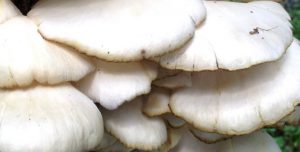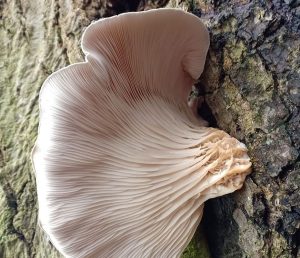
Last Updated on September 20, 2023 by Edible Alchemy Foods
When it comes to the world of mushrooms, there is an incredible diversity that can leave even the most seasoned forager perplexed. Among the many fascinating varieties of mushrooms, Angel Wing and Oyster mushrooms stand out prominently. These two types may appear similar at first glance, but they belong to different genera and have distinct characteristics, flavors, and uses.
In this comprehensive article, we will delve into the fascinating world of Angel Wing and Oyster mushrooms, highlighting their differences, culinary applications, and how to distinguish them in the wild.
Angel Wing Mushrooms
Appearance and Habitat
Angel Wing mushrooms, scientifically known as Pleurocybella porrigens, are delicate, ethereal fungi that are often found in temperate forests across North America, Europe, and Asia. These mushrooms are named for their striking resemblance to angel wings, with their white, fan-shaped caps that seem to flutter in the breeze.
Culinary Uses
While Angel Wing mushrooms may be visually captivating, they are not particularly known for their culinary appeal. In fact, they are considered mildly toxic when consumed raw or undercooked. However, when properly prepared, these mushrooms can be used in soups and stews to add a unique earthy flavor.
Identification
Identifying Angel Wing mushrooms requires careful observation. They typically grow on decaying wood, such as fallen logs or branches, and their white caps can reach up to 10 centimeters in diameter. The gills on the underside of the caps are thin, close together, and appear slightly serrated.
Oyster Mushrooms
Appearance and Habitat
Oyster mushrooms, on the other hand, belong to the Pleurotus genus and are a far cry from the delicate appearance of Angel Wings. Oysters are robust, with broad, shell-like caps that can range in color from white to various shades of brown. They are widely distributed across the globe and are often found on dead or dying trees, as well as decaying organic matter.
Culinary Uses
Oyster mushrooms are renowned for their exquisite flavor and versatile culinary applications. They have a subtle, nutty taste with a hint of anise and are prized by chefs worldwide. These mushrooms can be sautéed, grilled, roasted, or used in a variety of dishes, including stir-fries, pasta, and risottos.
Identification
Distinguishing Oyster mushrooms is relatively straightforward. Look for their characteristic oyster-shaped caps, which can measure anywhere from 5 to 25 centimeters across. The gills on the underside of the caps are white, closely spaced, and descend down the stem. Oyster mushrooms also lack a ring or veil, which is a key feature differentiating them from some toxic look-alike species.
Key Differences
Now that we’ve explored the individual characteristics of Angel Wing and Oyster mushrooms, let’s summarize the key differences between these two fungi:
- Genus: Angel Wing mushrooms belong to the Pleurocybella genus, while Oyster mushrooms belong to the Pleurotus genus.
- Appearance: Angel Wing mushrooms have delicate, fan-shaped white caps, whereas Oyster mushrooms have broad, oyster-shaped caps that vary in color.
- Culinary Use: Angel Wings are mildly toxic when raw or undercooked, limiting their culinary use. Oyster mushrooms, on the other hand, are prized for their excellent flavor and can be used in various dishes.
- Habitat: Angel Wing mushrooms typically grow on decaying wood, while Oyster mushrooms can be found on trees and organic matter.
Also, read:
- Difference Between Lentinellus Ursinus and Oyster Mushroom
- Difference between Abalone Mushroom and Oyster Mushroom
- Difference Between Shiitake Mushroom vs Cremini
- Are Oyster Mushrooms Supposed to Be Fuzzy?
Conclusion
While Angel Wing and Oyster mushrooms may share some visual similarities, they belong to different genera and have distinct characteristics that set them apart. Angel Wings are known for their delicate appearance and limited culinary use, whereas Oyster mushrooms are celebrated for their versatility and exquisite flavor.
So, the next time you venture into the world of mushrooms, armed with this knowledge, you’ll be better equipped to distinguish between these two fascinating fungi. Whether you’re a forager, a chef, or simply a mushroom enthusiast, understanding the difference between Angel Wing and Oyster mushrooms is sure to enhance your appreciation of the diverse world of mycology.











